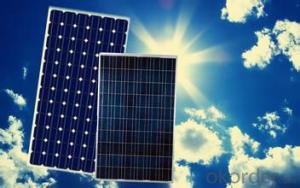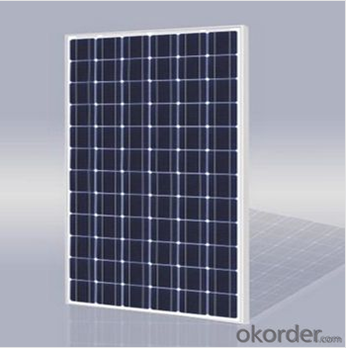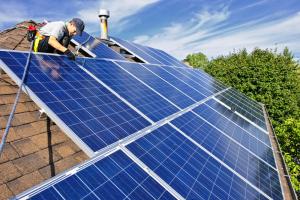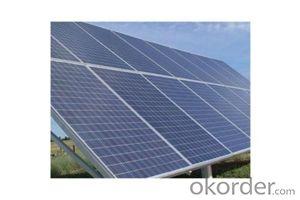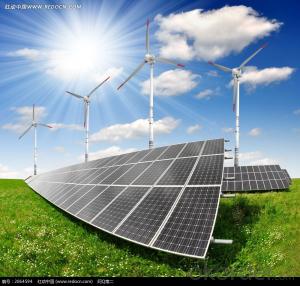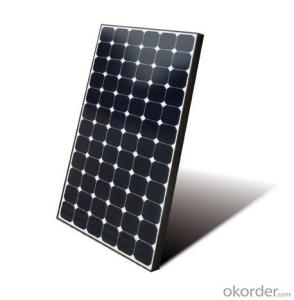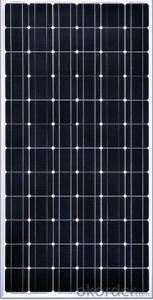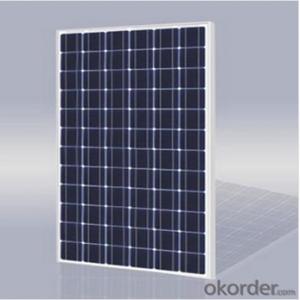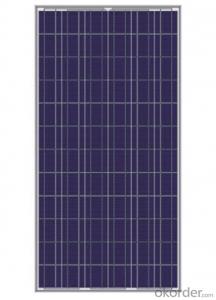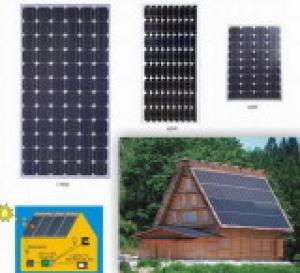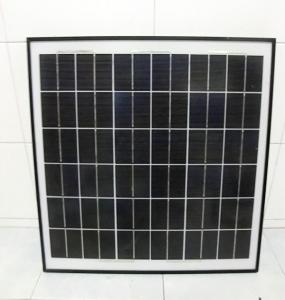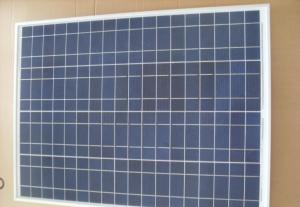Solar Panels Home Use - 65w CNBM Polycrystalline Silicon Panel
- Loading Port:
- China main port
- Payment Terms:
- TT OR LC
- Min Order Qty:
- 100 watt
- Supply Capability:
- 1000 watt/month
OKorder Service Pledge
OKorder Financial Service
You Might Also Like
Specification
65W CNBM Polycrystalline Silicon Panel for Home Using
Production description
Most solar modules are currently produced from crystalline silicon (c-Si) solar cells made of multicrystalline andmonocrystalline silicon. In 2013, crystalline silicon accounted for more than 90 percent of worldwide PV production, while the rest of the overall market is made up of thin-film technologies using cadmium telluride, CIGS and amorphous silicon[7]Emerging, third generation solar technologies use advanced thin-film cells. They produce a relatively high-efficiency conversion for the low cost compared to other solar technologies.
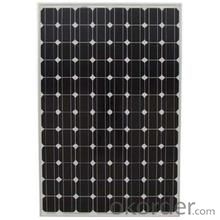
Feature
Optimized design for ease of soldering and lamination
Long-term stability,reliability and performance
Low breakage rate
Color uniformaity
Physical characteristic
1. Rigorous quality control meets the highest international standards.
2. High-transmissivity low-iron tempered glass, strong aluminium frame.
3. Using UV-resistant silicon.
4. IS09001/14001/CE/TUV/UL
- Q: Hi. I need to build a solar panel for a project. it should be able to light a 60 watt light bulb. also, it should be about 3x3 ft if it is 50% efficient. if anyone knows any websites or can help me, please answer! thanks.
- Making your own photovoltaic (solar electric) panel is a nontrivial matter if you want to get 60 watts out of it. If this is a science fair project, there are some possible paths that I'd suggest: ) Make your own cupric oxide panel. With just one square foot, you can harvest perhaps 0.5 mW in bright sun - enough to power a solar calculator; -or- 2) Buy a panel to light your 60 watt bulb. You could probably get away with a panel that is 6 square feet, but would use a car headlight as the lamp. If you wanted to light a regular household bulb, you would need electronics to step up the voltage, and you would lose a sizeable fraction of the energy just in the conversion. -or- 3) Buy broken solar cell pieces, or individual solar cells, and solder them together into your own panel. This is a LOT of trouble, and is a finicky process to get working and keep working. And it may not end up being cheaper than buying a ready-made panel. But you can claim that you made it! By the way, crystalline silicon panels are in the ballpark of 5% efficient, and a 3' x 3' one would produce in the neighborhood of 20 watts.
- Q: What are the advantages of using solar panels?
- There are several advantages of using solar panels. Firstly, solar panels produce clean and renewable energy, which helps reduce greenhouse gas emissions and combat climate change. Secondly, solar energy is abundant and free, reducing the dependence on fossil fuels and providing a sustainable source of power. Additionally, solar panels can save homeowners and businesses money on their electricity bills by generating their own energy. Finally, solar panels require minimal maintenance and have a long lifespan, making them a cost-effective and reliable energy solution.
- Q: Can solar panels be installed on government buildings?
- Yes, solar panels can be installed on government buildings. In fact, many local, state, and federal government agencies have already embraced renewable energy and installed solar panels on their buildings as part of their sustainability initiatives. This helps reduce their carbon footprint, save on energy costs, and demonstrate their commitment to clean energy solutions.
- Q: How much candle lights is required to operate a 205 watt solar panel?
- The intensity of direct sun is about 0,000 foot-candles. It would not be practical to light that many standard candles and put them foot away from the panel, but you could supply that intensity with electric lighting. That's in fact how they establish the power ratings of a given panel; they have a rig that provides a standard test condition of sun.
- Q: I want to buy a solar panel kit to run my central AC unit. it is a 3 ton unit. Can I do this? The electric rates in the Chicago area are skyrocketing and I can't keep paying 350 dollar electric bills during the spring and summer months
- I know that in Texas we wouldn't even try to run an air-conditioner on a generator without at least a 6,000 watt generator and we would prefer a 0,000 watt generator. The calculator on the Kohler website says it'll be 7,500 watts. At $5 per watt to install a solar photovoltaic system and assuming you also need to run it through the night and taking into account that an inverter can be as bad as 60% efficient, you're talking about $87,500 just to run your AC for 25 years. The first step in going solar is to significantly reduce your energy use. You're not going to maintain your current energy use on solar, at least not cost effectively. If you did want to run an AC on solar power, you may want to look at absorption air conditioning and use evacuated tube solar thermal collectors instead but don't expect it to be cheap and it usually only augments the use of natural gas in the absorption chiller.
- Q: I have the wattage of solar panel but i dont know about the voltage amp; current rating of it. Plz explain me about the voltage rating of solar panel.
- A okorder /
- Q: The battery is 9ah and the solar panel is 20w
- You need a switch mode voltage converter, made to input 2 to 20 volts, and output around 7 volts. Some cell phone chargers can do that, or be modified for that voltage. Option B is to get another battery and use the system at 2V, and regulate that to 6 or 5 volts for charging (you can directly use your car charger), with switch mode regulators. I would find that system to be more flexible. Getting an 8Ah would leave extra capacity. BTW, for a 9AH battery, 20W is kid of big. I have a 36Ah battery and a 20W panel, and that is good for it.
- Q: I hooked up a 2V solar panel to a small relay. The relay switches at 9V. When I have light shining on the panel it puts out aorund 3-4V, but when I hook it up directly to the relay it drops to V and doesn't switch the relay. Why? and How do I fix it?-2V Mono-Crystalline Solar Panel -JWD 7 4 reed relay
- Your solar panel output too little current that cannot be used to power the relay. Change the panel into 2V 500mA type shall work.
- Q: If this was sold back to the grids what would be the profit i would stand to make per day on energy received in these panels? How did you come up with this answer?
- Considering capital outlays, such a system might never recover its initial investment. That's why we don't see such small photovoltaic plants popping up around the country - the economic case isn't there. One of the problems is that you would have to sell your electricity wholesale, at a ridiculously low price like 2 cents / kWh. If you were displacing electricity that you would otherwise use, then the financial case is different. Retail electricity could be 20 cents / kWh, 0 times as much, and you could get your money back over time, and start to make a profit. I've assumed you're in the US, with no special feed-in tarrifs. If you're in a country with a premium rate for solar-generated electricity, the business case could be very different.
- Q: Can solar panels be used in areas with high levels of heatwaves?
- Yes, solar panels can be used in areas with high levels of heatwaves. In fact, solar panels can still generate electricity in extreme heat, although their efficiency may decrease slightly due to the temperature increase. However, it's worth noting that high temperatures can also lead to increased energy consumption for cooling, which may offset the benefits of solar energy to some extent. Nevertheless, solar panels remain a viable and sustainable solution for electricity generation in areas with high levels of heatwaves.
Send your message to us
Solar Panels Home Use - 65w CNBM Polycrystalline Silicon Panel
- Loading Port:
- China main port
- Payment Terms:
- TT OR LC
- Min Order Qty:
- 100 watt
- Supply Capability:
- 1000 watt/month
OKorder Service Pledge
OKorder Financial Service
Similar products
Hot products
Hot Searches
Related keywords
